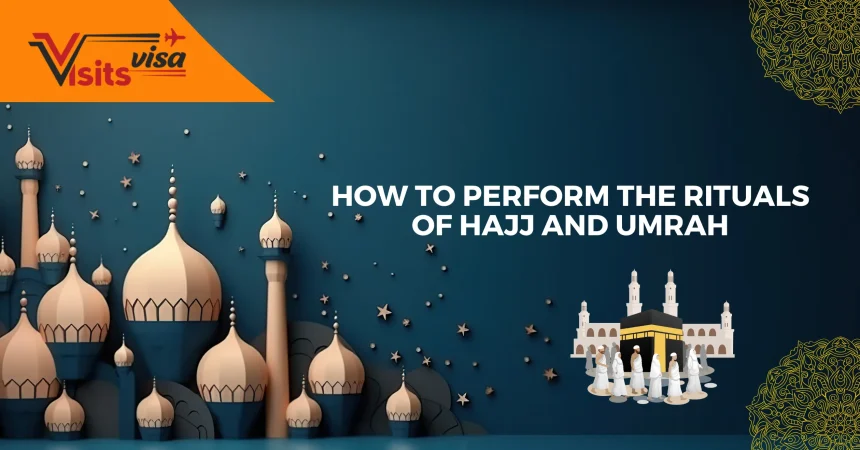Introduction
The sacred journeys of Hajj and Umrah hold immense spiritual significance for Muslims around the world. These pilgrimages to the holy city of Makkah offer a profound opportunity to renew one’s faith, seek forgiveness, and connect deeply with Allah. However, understanding the rituals involved, obtaining the necessary visas, and ensuring a smooth pilgrimage can be complex. This comprehensive guide will walk you through the essential steps of performing Hajj and Umrah, explain how to get an Umrah visa, and highlight why VisitsVisa stands out as the best Umrah visa provider.
Understanding Hajj and Umrah
Introduction to Hajj and Umrah
Hajj is one of the five pillars of Islam, a mandatory religious duty for Muslims that must be carried out at least once in their lifetime by those who are physically and financially able. It occurs annually during the Islamic month of Dhul-Hijjah. In contrast, Umrah is a voluntary pilgrimage that can be performed at any time of the year. While both pilgrimages involve rituals centered around the Kaaba in Makkah, Hajj is more extensive and includes additional rites in Mina, Arafat, and Muzdalifah.
Spiritual Significance
The spiritual significance of Hajj and Umrah is profound. These pilgrimages are acts of obedience and devotion, symbolizing the journey of life and submission to Allah. They offer a chance for spiritual rebirth, cleansing of sins, and a renewal of faith. Pilgrims are reminded of the unity of the Muslim ummah (community) and the equality of all believers in the eyes of Allah. The physical and spiritual exertions undertaken during these pilgrimages are meant to mirror the trials and sacrifices made by the prophets Abraham and Muhammad.
Performing Umrah
Entering the Haram
Upon entering the Holy Mosque, pilgrims are overwhelmed with a sense of awe and devotion. The first sight of the Kaaba is a moment of deep spiritual significance, prompting prayers and supplications. This experience is often described as life-changing, evoking a profound connection with Allah. Pilgrims often feel an immense sense of peace and unity with fellow believers, regardless of their backgrounds. It’s essential to take a moment to absorb the sanctity of the place, make heartfelt du’as (prayers), and mentally prepare for the upcoming rites. The tranquility and reverence felt in the Haram amplify the pilgrim’s spiritual consciousness, setting the tone for the rest of their Umrah journey.
Tawaf (Circumambulation)
Tawaf involves walking around the Kaaba seven times in a counter-clockwise direction. Pilgrims recite prayers and supplications during this act, symbolizing their unity with fellow believers and their devotion to Allah. Each circuit is an opportunity to reflect on one’s relationship with God, seek forgiveness, and express gratitude. The movement around the Kaaba also represents the constant turning of human hearts towards their Creator. Amidst the throng of worshippers, the experience can be both humbling and uplifting, reinforcing the pilgrim’s faith and commitment to Islam. The physical act of Tawaf, with its repetitive motion and continuous prayers, becomes a meditative practice, helping pilgrims to focus their hearts and minds solely on their Creator.
Sa’i (Walking Between Safa and Marwah)
Sa’i commemorates Hagar’s search for water for her son Ishmael. Pilgrims walk between the hills of Safa and Marwah seven times, reflecting on her unwavering faith and perseverance. This rite is a powerful reminder of the importance of trust in Allah and the human capacity for endurance in times of hardship. As pilgrims move between the hills, they not only retrace Hagar’s steps but also contemplate their own life struggles and the ways in which faith can provide strength and solace. The act of Sa’i thus becomes a personal journey of spiritual growth and reflection. Each step taken is a testament to Hagar’s unwavering faith and a pilgrim’s own commitment to seeking Allah’s guidance and mercy.
Tahallul (Shaving/Cutting Hair)
Tahallul marks the completion of Umrah rituals. Men shave their heads or cut a portion of their hair, while women cut a small part of their hair. This act symbolizes purification and renewal. It signifies a fresh start, free from past sins, and a renewed commitment to living a righteous life. The physical act of cutting hair is a tangible representation of the inner spiritual transformation that the pilgrim has undergone. It’s a moment of liberation and joy, often accompanied by prayers and thanksgiving to Allah for granting the opportunity to perform Umrah. This final step in Umrah rituals serves as a reminder that true devotion to Allah involves both inner purity and outward actions.
Performing Hajj
Ihram (State of Sanctity)
Ihram is the sacred state that pilgrims must enter before performing the rites of Hajj. It involves wearing specific garments: two white, unstitched clothes for men, and modest dress for women. More importantly, Ihram is a state of spiritual purity and dedication. Pilgrims must abstain from certain activities, such as cutting their hair or nails, and maintain a high level of conduct, focusing entirely on worship and the spiritual aspects of the pilgrimage. This state symbolizes the pilgrim’s detachment from worldly concerns and total submission to Allah’s will. Entering Ihram is a profound moment of transformation, marking the beginning of the pilgrim’s journey toward spiritual purification and renewal.
Day of Tarwiyah
The Day of Tarwiyah, the 8th of Dhul-Hijjah, marks the beginning of Hajj. Pilgrims travel from Makkah to Mina, where they spend the day in prayer and reflection. It’s a time to prepare mentally and spiritually for the intense rituals to follow. In Mina, pilgrims stay in tents, reminiscent of the humble conditions during the Prophet Muhammad’s time. This day is crucial for setting the tone for the rest of the pilgrimage, emphasizing humility, patience, and devotion. The simplicity of the accommodations in Mina serves as a reminder of the humble and austere nature of the Prophet’s life and the importance of focusing on spiritual growth over material comforts.
Standing at Arafat
Standing at Arafat, known as Wuquf, is the pinnacle of Hajj. On the 9th of Dhul-Hijjah, pilgrims gather at the plain of Arafat to spend the afternoon in supplication and contemplation. This day is often described as a rehearsal for the Day of Judgment, with pilgrims seeking forgiveness and making earnest prayers. The experience is profoundly moving, as millions of Muslims stand together in unison, all dressed in white, beseeching Allah’s mercy. It’s a time for deep introspection, spiritual cleansing, and renewal of faith. The shared experience of Wuquf fosters a sense of unity and brotherhood among the pilgrims, reminding them of the universal bonds that connect all Muslims.
Muzdalifah (Gathering of Pebbles)
After sunset on the Day of Arafat, pilgrims proceed to Muzdalifah. Here, they spend the night under the open sky, collecting pebbles for the ritual of Rami al-Jamarat (stoning of the devil). This gathering symbolizes the simplicity and unity of the Muslim community. Pilgrims perform the Maghrib and Isha prayers combined and rest, preparing for the next day’s significant rites. The experience of sleeping under the stars fosters a sense of humility and connection to the early pilgrims. The vast open landscape of Muzdalifah provides an opportunity for quiet reflection and prayer, reinforcing the pilgrim’s reliance on Allah and the transient nature of worldly life.
Rami al-Jamarat (Stoning of the Devil)
The stoning of the devil is performed over three days, starting on the 10th of Dhul-Hijjah. Pilgrims throw pebbles at three pillars representing Satan, reenacting the Prophet Abraham’s rejection of the devil’s temptations. This act signifies the rejection of evil and the reaffirmation of faith. It’s a powerful ritual that reinforces the commitment to follow the path of righteousness. Pilgrims reflect on their own struggles with temptation and seek Allah’s strength to overcome them. The act of stoning the pillars serves as a physical manifestation of the pilgrim’s inner resolve to reject sin and remain steadfast in their faith.
Sacrifice (Qurbani)
The ritual of Qurbani involves sacrificing an animal, usually a sheep, goat, or cow, to commemorate Prophet Abraham’s willingness to sacrifice his son in obedience to Allah’s command. This act, performed on the 10th of Dhul-Hijjah, is a profound expression of faith and submission. The meat from the sacrifice is distributed to the needy, promoting charity and community welfare. This ritual underscores the values of sacrifice, generosity, and compassion in Islam. The act of Qurbani serves as a reminder of the importance of selflessness and the significance of helping those in need.
Tawaf al-Ifadah (Main Circumambulation)
Tawaf al-Ifadah is a crucial rite of Hajj, performed after the stoning of the devil and the sacrifice. Pilgrims circumambulate the Kaaba seven times, seeking to draw closer to Allah. This ritual signifies a fresh start and spiritual renewal. It’s a moment of deep personal reflection and a reaffirmation of faith. Pilgrims often feel a profound sense of peace and fulfillment as they complete this essential rite. The act of Tawaf al-Ifadah symbolizes the culmination of the pilgrim’s spiritual journey and their return to a state of purity and devotion.
Final Days in Mina
During the final days of Hajj, pilgrims remain in Mina, performing additional rites and reflecting on their spiritual journey. These days are spent in prayer, reading the Quran, and making supplications. The experience fosters a sense of community and shared faith among the pilgrims. It’s a time for personal growth, introspection, and strengthening one’s relationship with Allah. The simple, communal living conditions in Mina reinforce the values of humility, patience, and brotherhood. These final days serve as a period of spiritual consolidation, helping pilgrims to internalize the lessons learned and the spiritual gains achieved during Hajj.
Obtaining an Umrah Visa
Application Process
Obtaining an Umrah visa is a critical step for those planning to undertake this pilgrimage. The process involves several steps, starting with filling out an application form, which can be done online or through an authorized travel agency. Applicants must provide a valid passport, recent photographs, and proof of travel arrangements, such as flight and accommodation bookings. Additionally, they may need to submit a vaccination certificate, particularly for meningitis. It’s essential to ensure all documents are accurate and up-to-date to avoid delays. The application process is designed to ensure that pilgrims are adequately prepared and meet all the necessary requirements for travel to Saudi Arabia.
Required Documentation
The required documentation for an Umrah visa includes a valid passport with at least six months’ validity from the date of travel, recent passport-sized photographs, and a completed application form. Applicants must also provide proof of round-trip airfare and confirmed accommodation in Saudi Arabia. A vaccination certificate for meningitis is mandatory. Women under 45 must be accompanied by a mahram (a male relative) or part of a group. It’s crucial to double-check all documents to ensure they meet the requirements set by the Saudi authorities. Proper documentation is essential to facilitate a smooth and hassle-free visa application process.
Processing Time
The processing time for an Umrah visa can vary, but it typically takes between one to two weeks. During peak seasons, such as Ramadan and the months leading up to Hajj, processing times may be longer. It’s advisable to apply well in advance of your planned travel dates to accommodate any potential delays. Staying informed about the current processing times and requirements is crucial for timely planning. Early application not only ensures sufficient time for visa processing but also allows for better preparation and peace of mind before embarking on the sacred journey.
Choosing a Visa Provider
Choosing a reliable visa provider is essential to ensure a smooth and hassle-free application process. A good provider offers clear guidance on the required documentation, assists with the application process, and provides timely updates on the status of the visa. They should have a track record of successfully handling visa applications and providing excellent customer service. It’s important to choose a provider that is accredited by the Saudi authorities and has positive reviews from other pilgrims. A reputable visa provider can significantly ease the process and provide valuable support throughout your journey.
Why VisitsVisa is the Best Umrah Visa Provider
Exceptional Customer Service
VisitsVisa is renowned for its exceptional customer service. Their team of dedicated professionals is available to assist pilgrims at every step of the visa application process. They offer personalized guidance, ensuring that all requirements are met and any issues are promptly addressed. This commitment to customer satisfaction sets them apart from other providers. Pilgrims can rely on VisitsVisa for accurate information, timely updates, and continuous support. Their customer-centric approach ensures that each pilgrim feels valued and supported throughout their journey.
Proven Track Record
VisitsVisa has a proven track record of successfully processing Umrah visas for thousands of pilgrims. Their expertise and experience in handling visa applications ensure a high success rate. They have built a reputation for reliability and efficiency, making them a trusted choice for many pilgrims. The company’s consistent performance in delivering results demonstrates their competence and reliability. Pilgrims can have confidence in VisitsVisa’s ability to facilitate a smooth and efficient visa application process.
Competitive Pricing
VisitsVisa offers competitive pricing without compromising on the quality of service. They provide transparent pricing with no hidden fees, ensuring that pilgrims receive excellent value for their money. Their affordable rates make it accessible for more people to perform Umrah. This commitment to fair pricing is part of their dedication to serving the Muslim community. Pilgrims can expect high-quality service at a reasonable cost, making VisitsVisa an attractive option for those planning their pilgrimage.
Comprehensive Support
VisitsVisa provides comprehensive support throughout the visa application process. They assist with filling out forms, collecting the required documents, and submitting the application. Additionally, they offer guidance on travel arrangements, accommodations, and other aspects of the pilgrimage. Their holistic approach ensures that pilgrims are well-prepared and supported every step of the way. This extensive support network is designed to make the pilgrimage experience as smooth and stress-free as possible. Pilgrims can rely on VisitsVisa for thorough and reliable assistance, from the initial application to their return home.
Positive Customer Feedback
Customer feedback for VisitsVisa is overwhelmingly positive. Pilgrims frequently praise their professionalism, efficiency, and dedication. Testimonials highlight their exceptional customer service, smooth application process, and reliable support. This positive feedback reflects the high level of satisfaction among their clients and reinforces their reputation as a top choice for Umrah visa services. The consistently high ratings and glowing reviews demonstrate the trust and confidence that pilgrims place in VisitsVisa. This positive reputation is a testament to their commitment to excellence and customer satisfaction.
Accessibility and Convenience
VisitsVisa offers an accessible and convenient application process. Their user-friendly online platform allows pilgrims to apply for their visa from the comfort of their home. They provide clear instructions and step-by-step guidance to simplify the process. Additionally, their customer service team is readily available to answer any questions and provide assistance. This accessibility and convenience make VisitsVisa a preferred choice for many pilgrims. The streamlined application process and readily available support ensure a hassle-free experience for all applicants.
Preparation and Planning
Proper preparation and planning are essential for a successful Hajj or Umrah pilgrimage. Pilgrims should familiarize themselves with the rituals and their significance, plan their travel and accommodations, and ensure they have all the necessary documentation. Understanding the physical and spiritual demands of the pilgrimage can help in making appropriate preparations. This includes getting into good physical shape, packing necessary items, and mentally preparing for the journey. Proper preparation ensures that pilgrims can focus on their spiritual experience without being distracted by logistical concerns. Thorough planning and preparation are key to a smooth and fulfilling pilgrimage experience.
Performing Hajj and Umrah
Performing Hajj and Umrah requires knowledge of the specific rituals involved. For Umrah, the primary rites include Ihram, Tawaf, Sa’i, and Tahallul. For Hajj, additional rites such as the Day of Tarwiyah, Wuquf at Arafat, Muzdalifah, Rami al-Jamarat, and Tawaf al-Ifadah are performed. Each ritual holds deep spiritual significance and must be carried out with sincerity and devotion. It’s important to understand the correct procedures and recitations for each rite. Pilgrims should also be mindful of maintaining the sanctity of Ihram and adhering to the rules and prohibitions. Performing these rituals with dedication and reverence is central to the spiritual journey of Hajj and Umrah.
Choosing VisitsVisa
Choosing VisitsVisa for your Umrah visa needs ensures exceptional service, a proven track record, competitive pricing, comprehensive support, and positive customer feedback. Their dedication to customer satisfaction and expertise in handling visa applications make them the best choice for pilgrims. With VisitsVisa, you can expect personalized assistance, timely updates, and reliable support throughout your journey. Their commitment to excellence and customer care sets them apart from other providers. Trusting VisitsVisa with your visa application ensures a smooth, efficient, and stress-free experience, allowing you to focus on your spiritual journey.
FAQs
What is the difference between Hajj and Umrah?
Hajj is a mandatory pilgrimage for Muslims, performed during the Islamic month of Dhul-Hijjah, while Umrah is a voluntary pilgrimage that can be performed at any time of the year. Hajj involves more extensive rituals and is one of the five pillars of Islam.
How long does it take to process an Umrah visa?
The processing time for an Umrah visa typically takes one to two weeks, but it can be longer during peak seasons. It’s advisable to apply well in advance of your travel dates to ensure timely processing.
Can I perform Umrah without a mahram?
Women under 45 must be accompanied by a mahram (a male relative) or be part of a group to perform Umrah. This requirement is in place to ensure their safety and security during the pilgrimage.
What documents are required for an Umrah visa?
Required documents include a valid passport, recent photographs, a completed application form, proof of round-trip airfare, confirmed accommodation, and a vaccination certificate for meningitis.
Why is VisitsVisa considered the best Umrah visa provider?
VisitsVisa is renowned for its exceptional customer service, proven track record, competitive pricing, comprehensive support, and positive customer feedback. They offer personalized assistance and reliable support throughout the visa application process.
What is the significance of Ihram in Hajj and Umrah?
Ihram is a state of spiritual purity and dedication that pilgrims must enter before performing Hajj or Umrah. It involves wearing specific garments and abstaining from certain activities. Ihram symbolizes detachment from worldly concerns and total submission to Allah’s will.
Conclusion
Performing the rituals of Hajj and Umrah is a deeply spiritual and transformative experience for Muslims. Understanding the steps involved, obtaining the necessary visas, and choosing a reliable visa provider like VisitsVisa can ensure a smooth and fulfilling pilgrimage. This guide provides comprehensive insights into the sacred journeys of Hajj and Umrah, helping pilgrims to prepare and embark on their spiritual journey with confidence and devotion.







